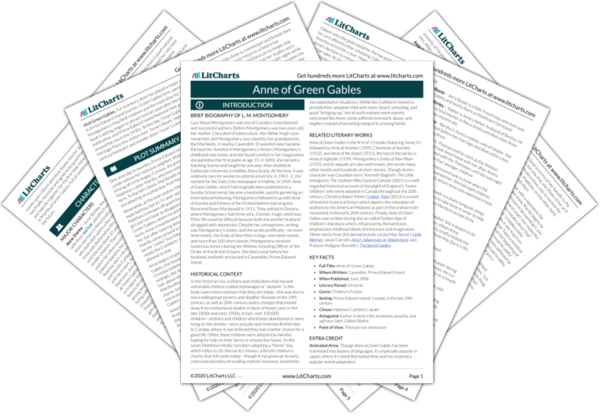Home and Family
In Anne of Green Gables, a middle-aged brother and sister, Matthew and Marilla Cuthbert, decide to adopt a young boy to help out around their Prince Edward Island homestead, Green Gables. By mistake, however, an 11-year-old girl named Anne is sent from the orphanage instead. Though Anne’s liveliness and affection quickly win Matthew’s heart, Marilla thinks that Anne won’t be as “useful” as a boy would be and nearly sends her back to…
read analysis of Home and FamilyBeauty and Imagination
When she questions Anne about her past, Marilla observes that Anne is reluctant to talk about it: “evidently she did not like talking about her experiences in a world that had not wanted her.” In fact, rather than dwelling on her unhappy childhood, Anne takes refuge in her imagination, finding comfort in nature’s beauty and thereby being inspired to imagine better circumstances for herself. Sometimes her imagination wanders too freely and gets Anne into a…
read analysis of Beauty and ImaginationFriendship
Anne Shirley’s favorite phrases include “bosom friends” and “kindred spirits.” Though these terms are somewhat interchangeable for Anne, they refer to best friends and to people who share similar outlooks on life, respectively. When Anne comes to Green Gables, she makes her first “bosom friend” in Diana Barry, finding that friendship can come easily to open-hearted people who are willing to be loyal to one another. Over time, Anne also discovers that while…
read analysis of Friendship
Mishaps, Milestones, and Growing Up
Much of Anne of Green Gables recounts Anne’s mistakes and failed efforts to “be good.” Sometimes these things happen because of simple inexperience, like accidentally getting Diana drunk on currant wine that Anne believed was raspberry cordial, or putting liniment oil into a cake instead of vanilla. Sometimes Anne’s mistakes are the result of just indulging her imagination too freely, like reenacting a Tennyson poem and almost drowning in the pond, or sheer stubbornness…
read analysis of Mishaps, Milestones, and Growing UpBoys and Romance
Though romance and courtship don’t occupy a large role in Anne of Green Gables, boys remain an ongoing source of curiosity, fun, and occasionally torment for Anne and her friends at Avonlea school. Anne’s imaginations about romance usually take the form of grand passions fraught with danger and tragedy; her firsthand experiences, however, contrast with this overblown reality. This is especially the case with her enemy, Gilbert Blythe, whom she meets when he…
read analysis of Boys and RomanceGod, Prayer, and Church
Anne of Green Gables depicts Christian language, concepts, and morals with which many of its original readers would have been familiar. In Avonlea, community life largely revolves around the local church. When Anne comes to Green Gables, her guardians take for granted that she’ll become an observant Presbyterian like them and most of their neighbors. At first, however, Marilla is scandalized by Anne’s unfamiliarity with basic religious practices like prayer and tries to mold her…
read analysis of God, Prayer, and Church






